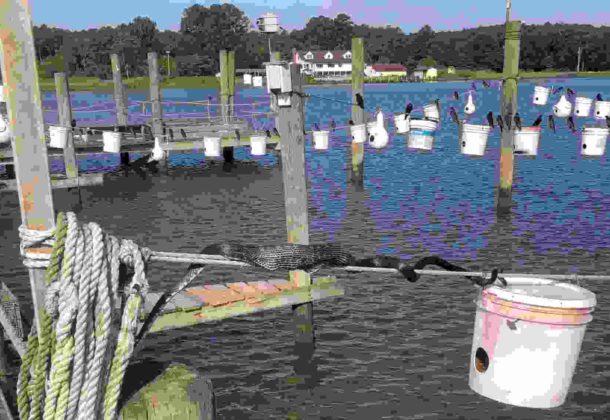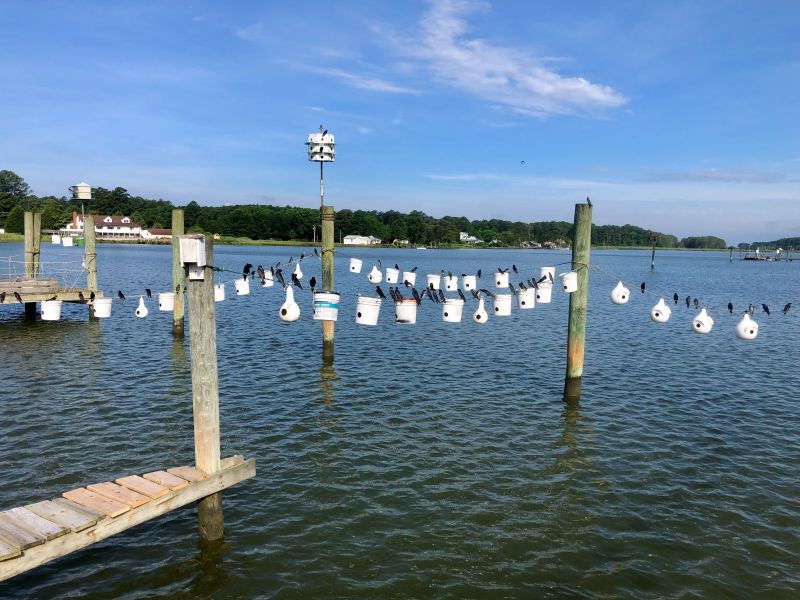Purple Martins Leaving Their Nests

Message From the Cap’n is a compilation of history, fishing advice, waterman and weather insights, Chesapeake lore, and ordinary malarkey from the folks who keep their feet wet in the Potomac and St. Mary’s rivers.
This month’s highlight: Purple Martins will be gone by the 1st of August!
The Purple Martins usually come here between the 10th and 13th of April, rest a little, scout the area and then begin nest building. And you know when they arrive. They start singing and don’t stop through the course of their stay.
The Purple Martin, North America’s largest swallow, is a swift and skilled flyer: The birds eat, drink, and even bathe on the wing. The species is part of a group of birds known as aerial insectivores — birds that feed on airborne insects. They do not eat as many mosquitoes as one might think. They feed on dragonflies more than anything else. They are cavity nesters, but the eastern populations depend almost entirely on man made housing. Housing can be as expensive as one might like, ranging from around $50 to $2 per house. I find that 2-gallon buckets, strung out over the water at my dock, work perfectly well as numerous birds come back year to year.
The Eastern Ratsnake, better known locally as a black snake, is the biggest predator at my location at the mouth of the Potomac River in Maryland, 20674. They are the biggest reason that many colonies are lost.
Black snakes are good to have around as they keep mice and rats at bay and are known to kill copperheads. But they like bird eggs and baby birds as well.
After much consternation and discussion with fellow birders, bird netting for fruit trees, is the best protection that I have found.
This bird netting wrapped around pilings and poles will entangle the snake, holding them till they can be “surgically” removed and relocated. By that, what I mean, the netting must be cut from them. Because their heads are smaller than their bellies they will continue into the netting until they ensnare themselves.

Netting wrapped around the line holding this manufactured martin house aloft prevents black snakes from raiding the nest inside.
Black snakes, weather, and other conditions can create a nest failure which will sour your birds about returning next year. Clean houses and repairs during their absence can help convince them to return year after year, bringing their summer of song with them.
But for now, that sudden silence of their absence is looming.
The fishing business has been good as of late. Mackerel, Perch, Spot, Bluefish, and Cobia have been plentiful. Hard head or Croaker not so good. Catfish and snakeheads are still on the rise with a years abundance of fresh water.
Blue crabs are plentiful with a lower price tag for the crabber. Males are in the $80-to-$90 range Maybe some of this will filter down to the consumer.
Sea nettles are just beginning to show up in the Lower Potomac.
Check it out: the Interpretive Buoy System provides updates daily about temperature and salinity conditions throughout the Potomac and the Chesapeake Bay. …
REMEMBER:
It’s Our Bay, Let’s Pass It On.
Till next time,
Cap’n Jack
[email protected]; 240-434-1385
To learn about tours and trips into the Chesapeake, get more information on Fins + Claws’ Leader Member Page. Visit Fins + Claws on Facebook and please share with your social media sites.
























